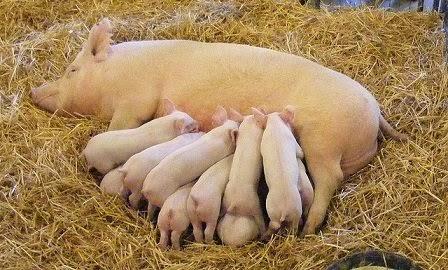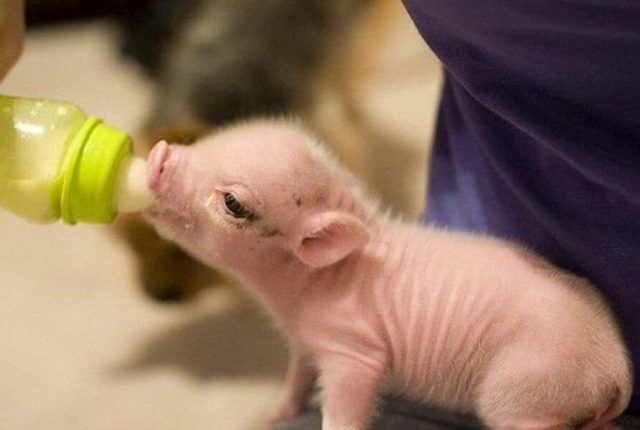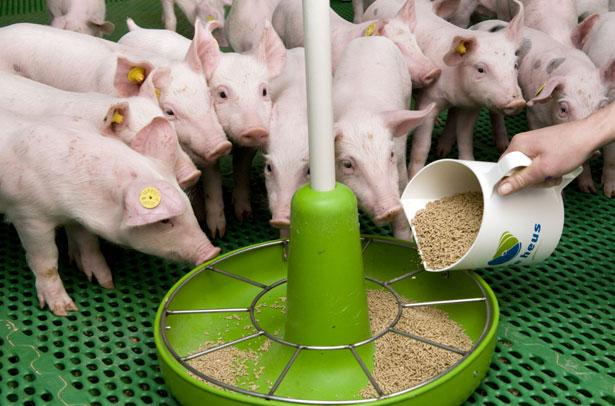Content
Weaning piglets from a sow can, without exaggeration, be called one of the most crucial stages in the activity of a pig breeder. Not only the welfare of the offspring, but also the effectiveness of further reproduction of an adult depends on how competently this procedure is carried out. Therefore, it is important to study the details of this difficult process in advance.
At what age are piglets beaten off from a sow
Among experienced pig breeders, discussions often arise about at what age it is more appropriate to wean piglets from a sow. There are two main weaning methods:
- Early.
- Late.
The choice of the optimal method for weaning piglets from the mother depends on the goals that the pig breeder pursues, since each of them has its own advantages and disadvantages.
Early weaning is called weaning of piglets before 2 months of age. It is most actively used on large farms with large animal populations. The advantages of the method include the following aspects:
- sows take less time to recover from piglets after fattening, as they are not as exhausted as during late weaning;
- from one sow it is possible to get more than 2 litters per year;
- after a short time, the pig can again happen to the boar;
- the digestive system of piglets develops faster due to the early introduction of solid foods;
- The sow, from which the litter was weaned, consumes less feed due to the fact that she does not need to feed piglets for a long time, and this, in turn, significantly saves money.
Late weaning is carried out after the piglets have reached the age of 2.5 months. This method is rarely used in farms where pigs are raised on an industrial scale, since it is less profitable from an economic point of view. However, it also has certain advantages:
- at late weaning, a stronger offspring is obtained, in which there are fewer weakened individuals;
- piglets are much less likely to get sick and have a stronger digestive system.
The disadvantages of this weaning method include:
- if the piglets are not weaned before 2 months, the mother's weight decreases many times faster, which is why she does not enter the hunt for a longer time;
- the rearing sow needs to eat more, which entails additional costs;
- young animals that were weaned at the later stages of growth find it more difficult to switch to solid food and are more often picky;
- Piglets are very upset about parting with their mother, which negatively affects their health.
For these reasons, most pig breeders prefer to wean the litter from the sow before the piglets are 50 to 60 days old. However, in some cases, farmers practice even earlier weaning.
At what age do the piglets wean early
With the right approach, it is possible to wean young animals from the sow even before the piglets are 1 month old. In this case, they talk about super early weaning. It has all the advantages of weaning early, while further reducing the cost of keeping the sow and allowing an increase in the annual number of farrowings. Nevertheless, such a method in the CIS is rarely practiced due to the fact that weaners under the age of 26 days need a special diet made from milk and specialized concentrates, which are very expensive and difficult to obtain.
There is no unequivocal answer to the question of when it is better to wean the piglets from their mother: each pig breeder must decide for himself when to carry out this event. However, no matter what timeframe weaning takes place, it is necessary to approach such a procedure with all care.
How to wean piglets from a sow
Competent weaning of piglets from a sow is a guarantee of further health of both the offspring and the mother. This process requires caution, since any wrong action can traumatize the psyche of animals and cause them health problems. Careful preparation can help mitigate the effects of weaning.
Weaning preparation
For piglets, separation from their mother is always a great stress, so it is necessary to prepare them for this gradually. Conditionally, preparation can be divided into 2 stages:
- introduction of solid foods;
- reducing the amount of time spent with the mother.
So, at the stage of introducing complementary foods, you should adhere to the following rules:
- Starting from the 3rd day of life, the offspring must be watered daily with boiled water, so that the microflora necessary for processing more solid food is formed in the piglets' organisms.
- On the 5th day, it is worth introducing boiled cow's milk into the diet of young animals.
- The menu for 7-day-old piglets can already be diversified with a thick mixture made from oatmeal in water or milk.
- On the 10th day, it is worth giving the youngsters finely chopped high-quality hay.
- The litter at the age of two weeks is already capable, in addition to milk, to assimilate fresh grass and roots.
During the introduction of complementary foods, it is necessary to leave the piglets the opportunity to feed on mother's milk. In this case, the offspring should be kept together with the sow.
How to Wean Properly
As soon as the piglets get used to the new type of nutrition, weaning can begin. For this:
- A few days before the procedure, the sows suppress milk production by reducing the amount of succulent food and drink. The day before weaning the offspring from the mother, the amount of feed is reduced by 50%.
- At the same time, piglets begin to be weaned from their mother for a short period, each day increasing the time of separation. Ideally, the young are brought to the sow only for the feeding period.
- The number of meals for the offspring is also gradually reduced from 6 to 1.
- After the sow is removed from the piglets, the weaners are kept in the pen in the same environment for about 7 to 10 days to reduce the effects of stress on the animals.
Weaning pigs care
Weaning pigs need special care, even if weaned them from their mother without any major complications. Additional attention should be paid to the well-being of the young for 2 to 3 weeks after weaning.
Feeding
Once without a mother, weaners can begin to feed more intensively than usual. This is how the stress response manifests itself. In this case, pig breeders should cut the daily ration of young animals by 20% for 3-4 days. This will help eliminate overeating and prevent problems with the delicate gastrointestinal tract of animals. In the next 7 - 10 days, the amount of feed should be gradually returned to the previous volume.
Feeding the young after weaning is carried out 5 times a day, using only fresh finely chopped food. The feed can be left in the pen for a time not exceeding 1.5 - 2 hours, since the digestive system of the weaners is not yet sufficiently strong and food that has been stored for a longer time can provoke intestinal infections. The post-weaning piglet diet must include:
- 20% juicy greens;
- 70% quality concentrates;
- 5% of animal products (milk, eggs);
- 5% grain mixtures.
Weaners are often prone to anemia, therefore it is necessary to enrich their menu with food supplements and vitamins containing iron.
If it is necessary to wean the piglets from the sow earlier than 1 month, it is necessary to attend to providing the young animals with a sufficient amount of cow's milk. The daily rate for 1 piglet is 20 liters, while feeding the animal should be carried out at intervals of 2 - 3 hours. From two months, weaners are transferred to solid food, continuing to feed them with milk 5 times a day.
Content
Piglets that have stabilized after weaning can be grouped. Weaners, more physically developed, are united in herds of 20 - 25 individuals. Small and weakened animals are divided into groups of up to 15 individuals. The latter provide more intense nutrition for weight gain.
All young animals must be thoroughly washed and treated with formulations from parasites and viruses. This will not only serve as the prevention of diseases, but will eliminate extraneous odors that can irritate piglets and provoke conflicts between animals from different litters. At the same time, weaners are vaccinated.
In the premises where piglets are kept, which were weaned from their mother by a very early method, it is worth especially carefully to maintain cleanliness and monitor temperature indicators. The air temperature in such pens should remain within the range of 20 - 25 ° C. Older weaners should have easy access to a feeder and fresh drinking water.
Pig maintenance after weaning piglets
The sow from which the litter was weaned also requires increased attention. Proper nutrition and care will help her recover from fattening faster and get back to normal as soon as possible.
Feeding
The time of arrival of sows in heat directly depends on how much they are fattened. For 2 months of fattening piglets, a female can lose up to 30 kg, and if the offspring were weaned later, then all 50 kg. In emaciated females, interest in breeding is significantly reduced, therefore, it would be advisable for such sows to increase the amount of food by 15 - 20% before mating. This will significantly increase the efficiency of fertilization. Some pig breeders use the flushing method to feed weakened sows, which consists in increasing the amount of food by 25 - 30% 1 - 2 weeks before insemination. After mating, the volume of food is reduced to the usual indicators.
Content
Apart from a special diet, caring for a sow is not much different from caring for other pigs. Often it comes down to keeping the pen clean, regular hygiene procedures, and a stable drinking regime.
The sow should not be kept in the same pen with the piglets during the post-weaning adaptation period; it is better to provide her with a separate room.
It is also worth inspecting the female, in particular, her udder, which is necessary to prevent the development of mastitis. If there are warning signs, you should immediately seek help from your veterinarian.
When the sow is ready for the next farrowing
After the piglets have been weaned from the sow, her condition should be carefully assessed. Females that did not emaciate much during the feeding of the offspring, as a rule, come into heat 7 - 12 days after weaning, after which they can be mated with a boar. The mating is carried out 2 times with a break of 10 - 12 hours.
Lean sows should be fed first and given time to get in shape. Insemination is organized during the next estrus, after 20 - 25 days.
Conclusion
Whenever piglets are weaned from a sow, it requires the pig breeder to be attentive to the well-being of the animals and to the conditions of their keeping. If you strictly follow the nuances of the procedure, it is quite possible to wean the young from the mother with minimal difficulties and without financial losses.













